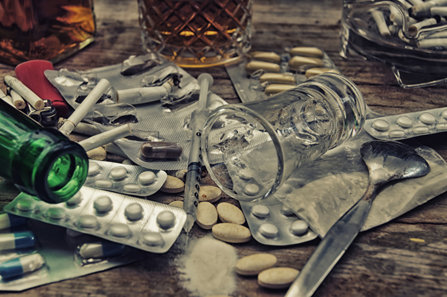7 Reasons We Must Avoid “Tunnel Vision” as We Fight Addiction

If you scan media coverage of America’s problems with drug addiction and overdoses, you’ll notice an enormous amount of coverage on the opioid epidemic. Heroin, fentanyl, oxycodone, hydrocodone—these drugs have taken hundreds of thousands of lives. It is understandable that the attention of many people, including professionals in law enforcement and government, has been riveted on this specific aspect of our problem with drug abuse and addiction. But it could be very dangerous to allow ourselves to develop tunnel vision as we work to save lives.
Specifically, there are seven reasons that would be dangerous and I’ll list those in a moment. Here’s the biggest problem with a tunnel vision approach: Our real situation is not simply that people are using opioids. It’s that they are using a whole lot of everything.
That’s the true situation we should be fighting—not just the use of opioids, but the use of a long list of drugs, including alcohol. In a recent New York Times article, Keith Humphreys, a professor at Stanford University School of Medicine, was quoted as saying: “We have multiple drug problems in the U.S. We need to focus on more than one drug at a time.”
This broader situation doesn’t make the headlines as much, but if you look just a little deeper into the news and reports from state and federal agencies, the necessity is there.
Here are the reasons that it’s vital to not let that tunnel vision take over.
- NUMBER ONE: Both cocaine and methamphetamine are currently making a comeback. The New York Times just published an analysis of the lives being lost to cocaine. They found that cocaine kills more African-Americans than heroin does. Cocaine use declined for several years and so interest in addressing cocaine addiction waned. But coca crops in South America are thriving again and we’re seeing more of this drug in our country as a result. Another report notes that in West Virginia, a surge in their methamphetamine supply has resulted in a 500% increase in drug deaths in which methamphetamine is involved.

- NUMBER TWO: Most addicted people are polydrug users (use of more than one drug at a time or in quick succession). In most cases of drug overdose, there is multiple drugs present and the coroner’s job is to figure out which drug was most likely to have been the cause of death. In some cases, it’s an impossible task, in which case the official cause of death becomes “polydrug intoxication.” The Institute for Research, Education and Training in Addictions notes: “Most people who die of a drug overdose die from more than one drug. Do young people understand that experimenting with multiple drugs can be much more dangerous that experimenting with one at a time?” We should not focus so strongly on opioids that we fail to address polydrug consumption.
- NUMBER THREE: The majority of young people who will eventually become addicted don’t start with opioids. According to the National Center on Addiction and Substance Abuse, the starter drugs are tobacco, alcohol, marijuana, and pills, which could include opioids, sedatives, tranquilizers or stimulants. If our overwhelming focus is on treating addiction to opioids, we reduce the amount of funding and effort we can apply to preventing young people from using any of these starter drugs. Once they’ve started using one of these drugs that they may think of as pretty harmless, it’s so much easier for them to migrate to something that offers more “kick”—and that is also far more addictive.
- NUMBER FOUR: Medication-assisted treatment (MAT) with Suboxone is a much-ballyhooed solution for a person who is addicted to painkillers, heroin or illicitly-manufactured fentanyl. With MAT, a person takes a daily dose of a pharmaceutical opioid that keeps withdrawal sickness from kicking in. But they can still get high off other drugs. Alcohol, marijuana, stimulants like methamphetamine or cocaine—Suboxone does not affect the high from any of them. As covered in detail in a 2013 New York Times article, the use of Suboxone in treatment is fraught with problems. It is itself a drug that is abused, and some people prescribed this drug still reach for Xanax, cocaine, alcohol or other drugs.
- NUMBER FIVE: There’s a wide range of substances that create addiction—inhalants, prescription and illicit stimulants, prescription tranquilizers and sedatives, prescription and illicit opioids, alcohol, marijuana, a long list of synthetics and various plant substances like kratom and khat. At this time, there are only two classes of drugs that have broadly-accepted medication-assisted treatment approaches: alcohol and opioids. If funding and focus are both riveted on opioids and, in particular, a medication-assisted treatment approach to opioid addiction, we are not finding solutions to addiction to any of these other drugs.

- NUMBER SIX: An intense focus on opioids completely overlooks the “elephant in the room”—the human tragedy, illness and death caused by overconsumption of, and addiction to alcohol. Globally, the World Health Organization estimates that more than 3 million people lose their lives each year as an effect of alcohol consumption. Their 2014 report notes that alcohol is a factor in or direct cause of 200 different illnesses or health conditions. For comparison, the number lost to drugs totals around 200,000, according to the United Nations Office on Drugs and Crime.
- NUMBER SEVEN: Official reports and legislation now lean in the direction of channeling those who are addicted into MAT programs and only these programs. If we permit a tunnel vision approach to addressing the opioid epidemic, this means that many more people are going to be prescribed Suboxone (buprenorphine-naloxone) or methadone. With that single-minded focus, we completely ignore the possibility that there are holistic methods of recovering from addiction to opioids.
For over fifty years, the Narconon program has enabled those who are addicted to recover their sobriety without relying on the use of any drugs. And not just their sobriety—they also recover their ability to enjoy their new sober lives because they no longer feel the need for drugs. Without a broad, holistic approach to rehabilitation, some people on MAT programs who still struggle with life’s challenges may look to other drugs for a high.
There is, in fact, a big difference between “treatment” and “rehabilitation.” At Narconon centers, our focus has always been rehabilitating a formerly-addicted person so they no longer need any drug or intoxicating substance and preventing the use of all drugs or intoxicants. With the phenomenally dangerous drugs on the market these days, the only safety lies in sobriety.


 ®
®